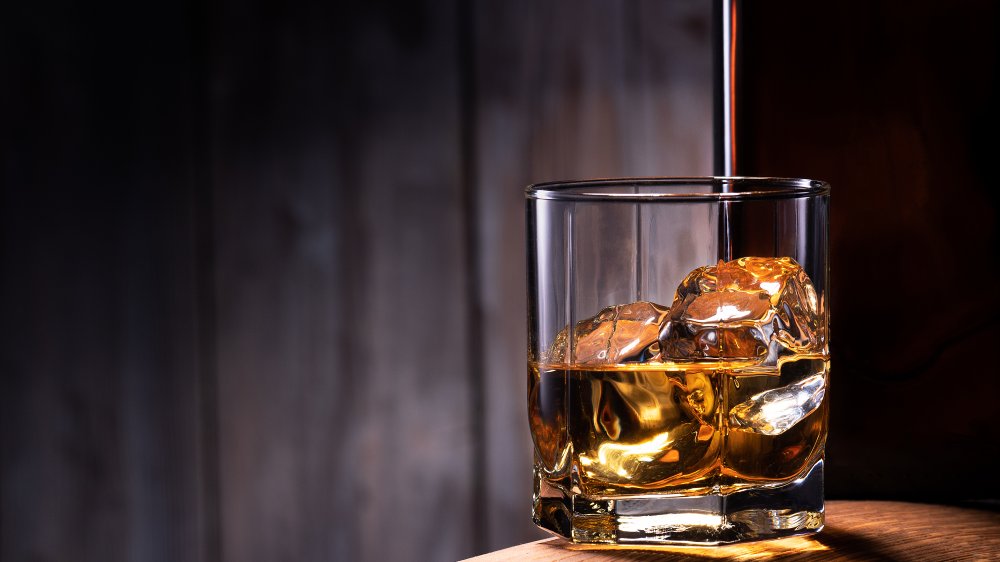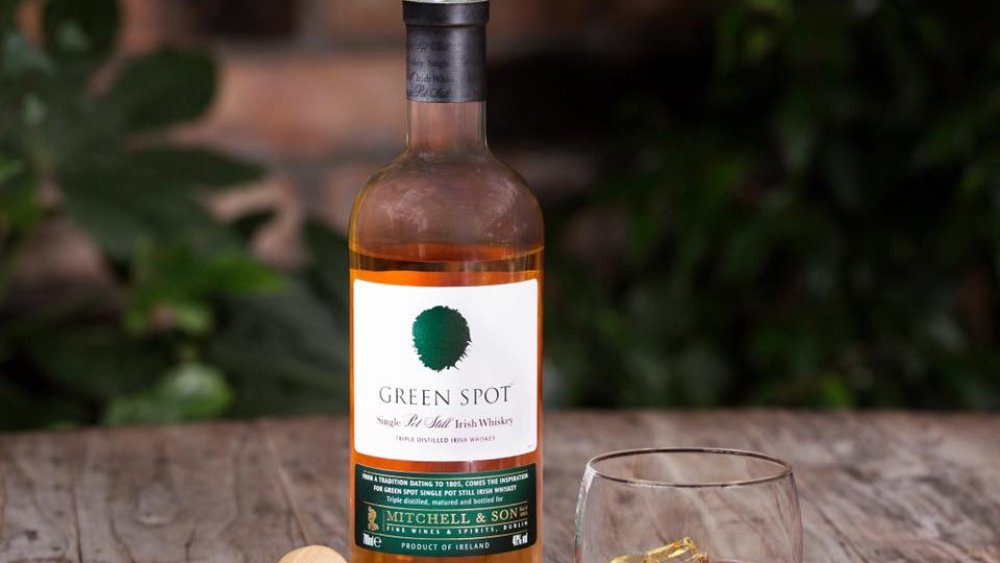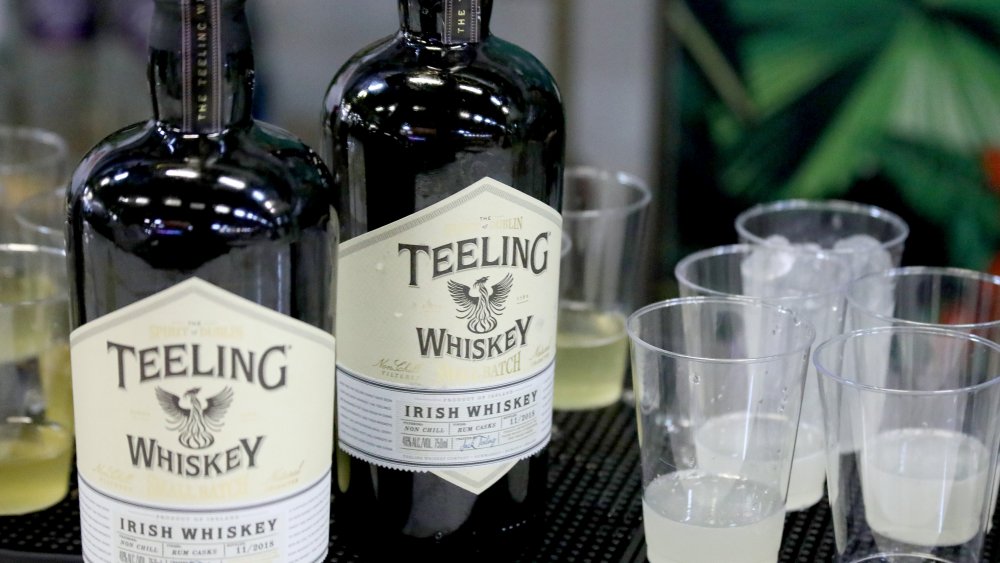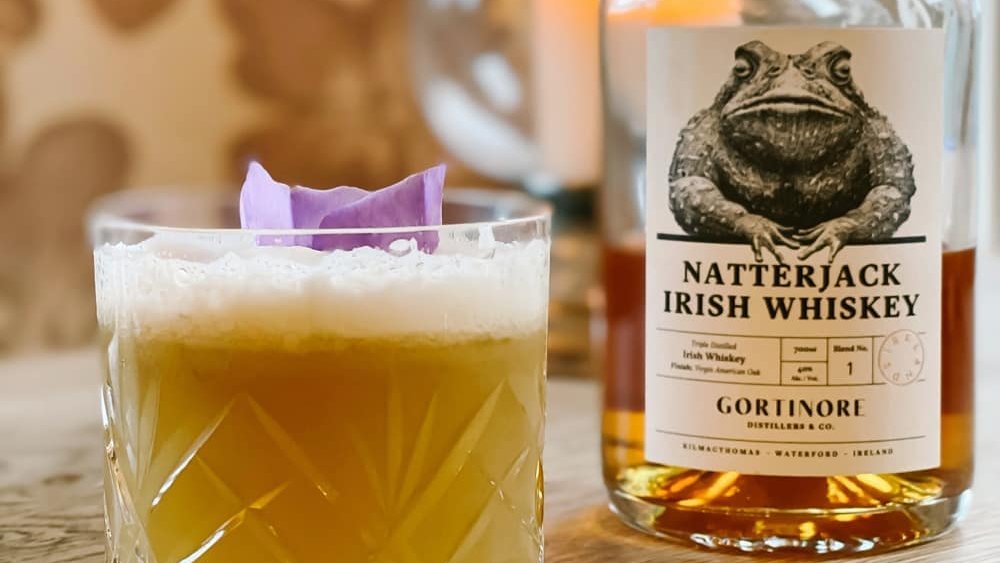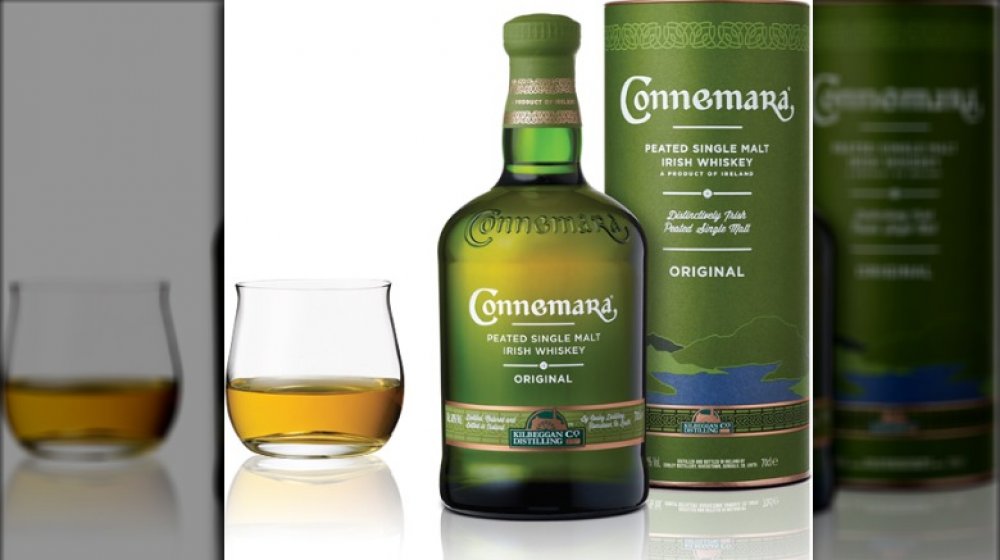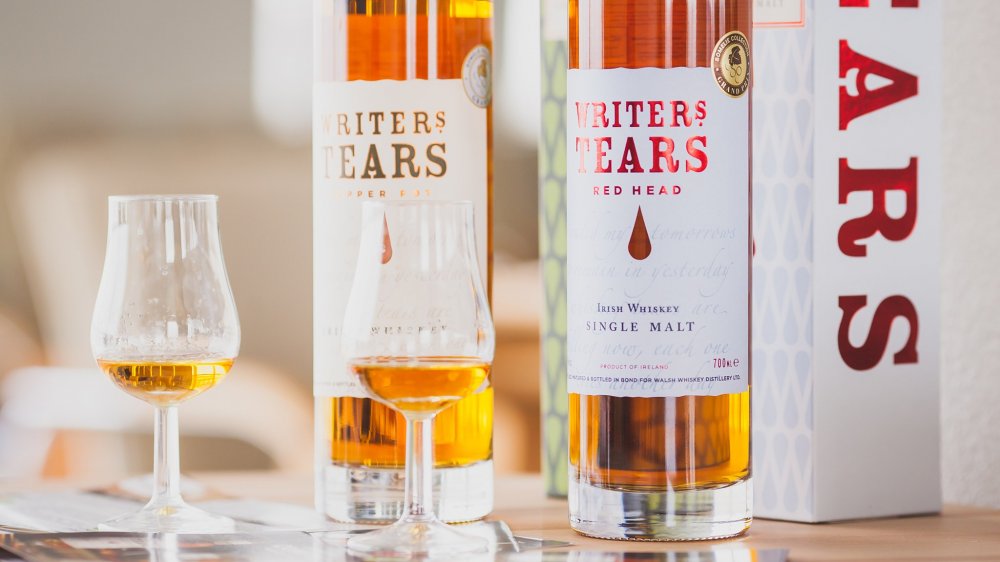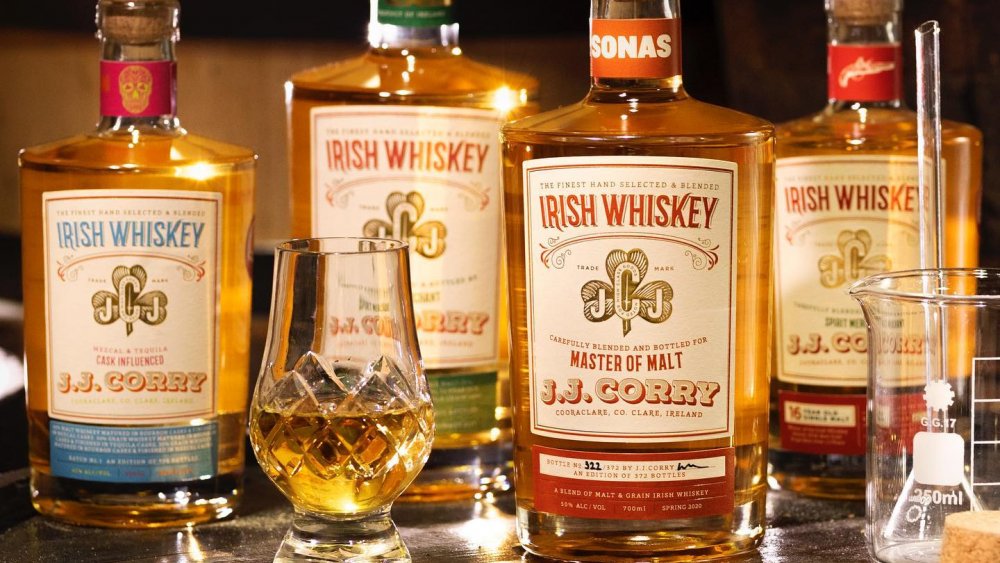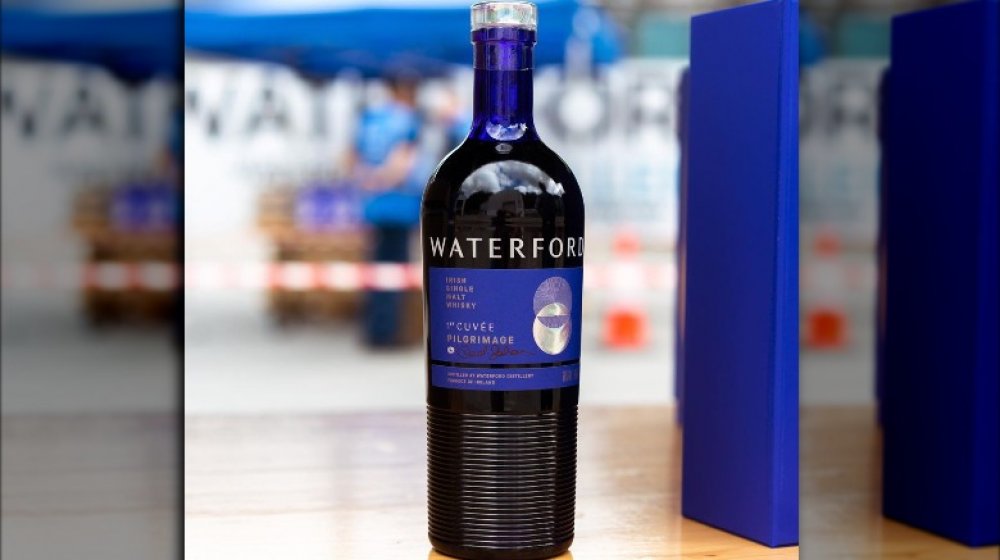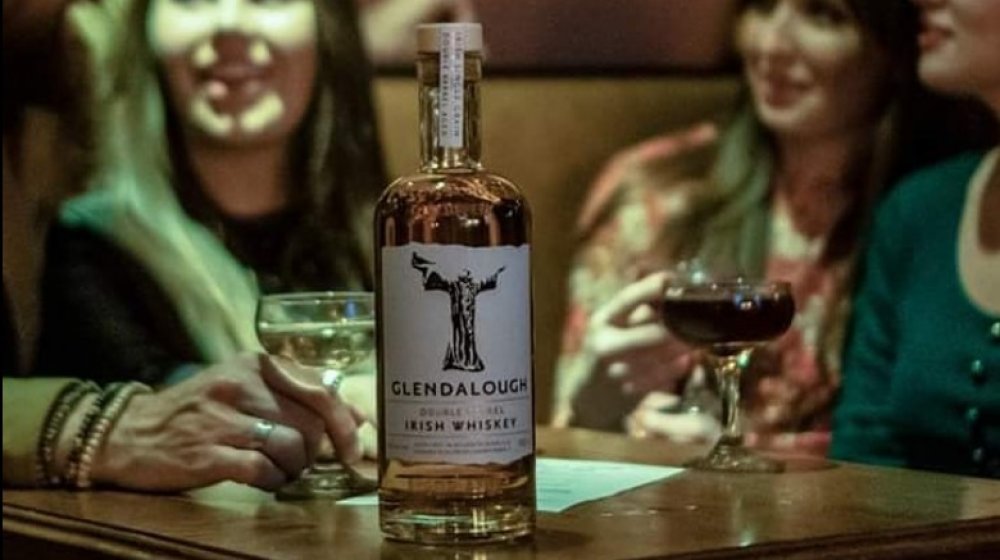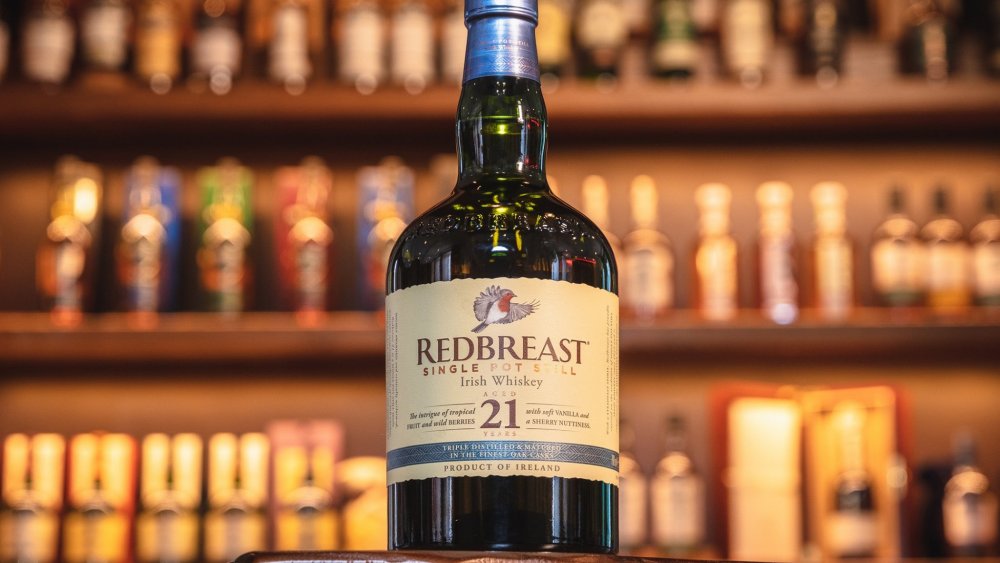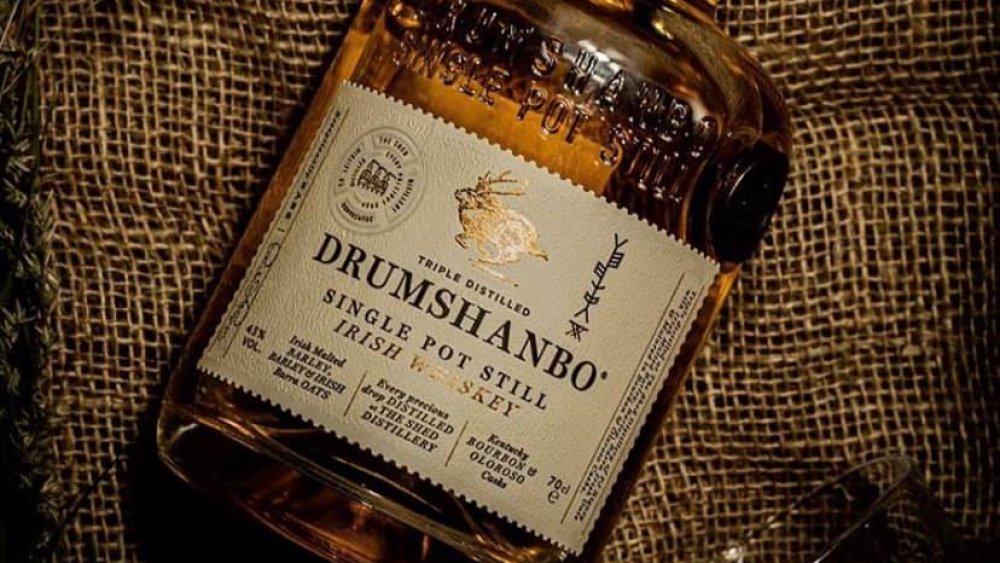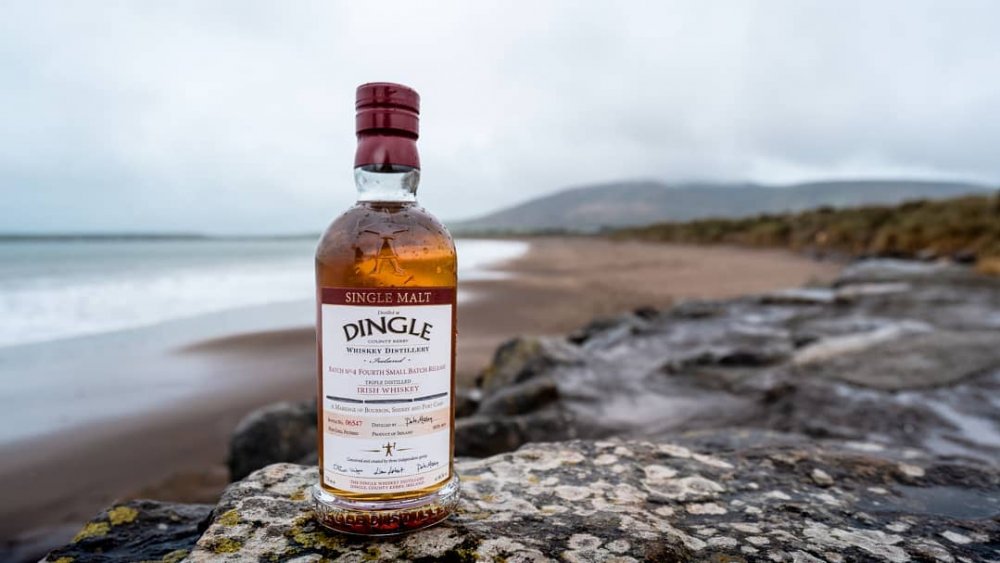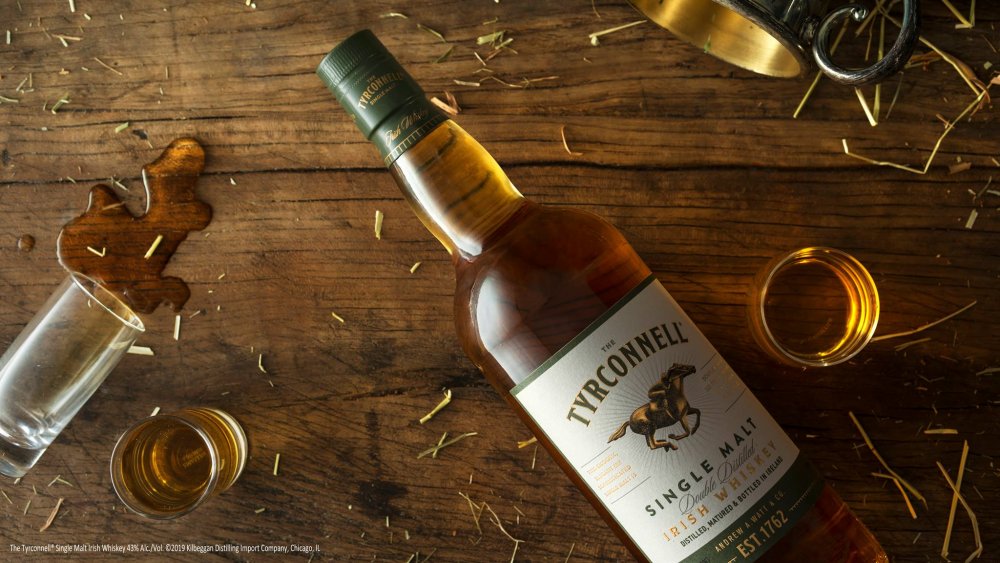Irish Whiskey You Need To Try That's Not Jameson
There's Jameson Irish Whiskey and then there's, well, every other kind of Irish whiskey. If you conjure up images of Jameson when you think of Irish whiskey, you're not wrong, but you absolutely shouldn't stop there.
Jameson is by far the most well-known label. It's the bottle that shows up at every Saint Patrick's Day party — for better or worse. But if you're looking for a bottle of something different and new, you actually have a ton of choices. Jameson is produced at Midleton in County Cork and it's still the biggest kid on the block. Midleton puts out 64 million liters of whiskey each and every year.
However, Distiller revealed that the number of smaller whiskey distilleries putting out their own products had reached a 120-year high in 2019. As 2019 became 2020, there were 31 new distilleries up and running, with a handful more still in the works. That's a huge jump, considering just 15 years prior, there were only three. And that means there's going to be a lot of Irish whiskey showing up on the shelves all over the world. What should you reach for? Here's a breakdown some of the best on the market, and a few that you should keep your eye on.
Green Spot Irish whiskey
In 2019, the Irish Whiskey Awards handed a gold medal to the unusually-named Green Spot. The name, much like the whiskey itself, has a surprisingly long history. Spot Whiskey dates back to the 1800s, at which time barrels were marked with different colored spots to indicate how long they were to spend aging. A green spot signified an aging period of seven to ten years, maturing away in casks once used for sherry and bourbon.
Fun fact: Green Spot was originally made by Mitchell & Son, which didn't actually start out as a whiskey distillery at all. The company started out as a bakery and cafe that served Dublin's ladies lunch and whiskey — cleverly disguised in teacups, naturally. The business got so popular that eventually Mitchell & Son started making their own whiskey. Green Spot is a single pot still whiskey like it was back in the 1800s, but now it's part of Midleton's line.
History aside, what can you expect when you pour yourself a sipper? Master of Malt's tasting notes reveal that you'll first get sweetness, the smells of peppermint, vanilla, sweet barley, and a bit of porridge. You'll be able to taste the bourbon notes courtesy of the aging process and if you've ever wondered just what that delicious-smelling dish of potpourri tastes like, this'll give you an idea. Lastly, there's vanilla — lots of it, carried on an incredibly smooth whiskey.
Any Irish whiskey by Teeling
When Teeling opened its distillery in 2015, they became the first new distillery to open in Dublin, Ireland in 125 years, according to the whiskey maker. But, they're not actually "new."
Way back in ye olde days of 1782, Walter Teeling opened a distillery in an area of Dublin called The Liberties. The area was so well-known for its three powerhouse distilleries (Power, Roe, and Jameson) that it was dubbed the Golden Triangle. However, they only made up a few of over three dozen distilleries in the area.
According to Difford's Guide, Teeling met the same fate as all the other distilleries in The Liberties: It closed. The number of whiskey distilleries dropped from 100 in 1886 to just two in 1970, and the shocking decline was the subject of a Harvard thesis written by John Teeling. Teeling went on to open the Cooley Whiskey Distillery and resurrected some of the old brands.
Jim Beam bought Cooley in 2012, but there was a catch. John's sons, Jack and Stephen, negotiated to sell the distillery but keep 16,000 casks. Those casks are what launched the new Teeling and thanks to the capital from that, they're up and running and producing some seriously amazing whiskey of their own. You can't go wrong with any bottle bearing the Teeling name. In just a few years, they've already accumulated more than 250 awards from international competitions, including a 2019 World Whiskies award for the world's best single malt.
Natterjack Irish whiskey
Natterjack is the flagship Irish whiskey of Gortinore Distillers & Co. of County Waterford. They distillery is based in a building that started out as a woolen mill during the famine years. When cousins Aidan and Lisa Mehigan decided to open a completely independent whiskey distillery in 2014, they turned it into the only distillery retrofit into a building more than a century and a half old, according to Natterjack.
We have to talk about the elephant in the room: What the heck is a natterjack? It might sound like something from a Lewis Carroll poem, but it's actually Ireland's rarest amphibian. The natterjack toad is only found in a few places in County Kerry and it's super strange in that it doesn't hop, it walks (via HSI). And that made it the perfect namesake for an Irish whiskey that wanted to set themselves apart and do something completely unlike the rest of the pack.
Yes, the cousins' goal was to make something wholly unique, something that had never been done before in Irish whiskey. The result is definitely that. The first whiff brings scents of apple, cinnamon, and vanilla, while tasting it reveals an unusual combination that absolutely works: cedar, orange, spice, and a hint of tobacco. Oh, and no hint of amphibian.
Connemara Peated Single Malt Irish whiskey
If you're a fan of scotch, one of the things you probably know is that some scotch is known for having a distinct peaty flavor. And if you love a good scotch with a heavy peat flavor, you'll definitely want to try Ireland's only whiskey to have that same unmistakable taste.
That's Connemara's Peated Single Malt Irish Whiskey, an Irish whiskey made from malted barley that's been dried over a peat fire. It has the smoothness of a traditional Irish whiskey as well as the smokiness from the peat — and it's pretty amazing. That's not all you get, though. There's also notes of apple and vanilla, a bit of honeysuckle, and the barley comes through, too. Basically, imagine tasting an apple crumble that was cooked over a wood fire... then turned into whiskey. Whiskey that, The Whiskey Exchange revealed, is made even better with the addition of a little water, to really bring out that distinctive smell.
Start with the Original and if you end up wanting more peatiness, try Cask Strength, which is even stronger. If you're looking for something to sip while sitting in front of your own crackling fire, Connemara is for you.
Writers' Tears Irish whiskey
Walsh Whiskey started out with a focus on making the perfect Irish coffee. The company was founded in 1999, but in 2009 the label released their boutique Irish whiskey Writers' Tears. Walsh Whiskey won a ton of awards for it, but you don't want to hear about that — you want to hear about the whiskey itself, right? Or, more accurately, whiskeys.
Walsh Whiskey has since come out with other versions of Writers' Tears and they're all amazing. Looking for something with a bit of apple and butterscotch, something reminiscent of old-school spiced pot still whiskey? Try the Copper Pot. If you're a fan of sherry, try the Red Head, which is matured in Oloroso sherry casks. The distinctive red color is immediately apparent and upon your first sip, you'll notice the creamy taste of orange, sherry, plums, and raisins. You could also try the Double Oak, which is fruity with hints of chocolate and vanilla.
There's been a few rare releases, too. The Copper Pot Marsala Cask Finish was, as the name suggests, finished in Sicilian wine casks while the Copper Pot Deau XO Cognac Cask Finish was finished in casks that spent a decade or longer aging cognac. You absolutely can't go wrong with a standard release for regular sipping and a rare edition for those special occasions.
J.J. Corry Irish whiskey
The story behind J.J. Corry is almost as complex as its whiskey. It was founded by Louise McGuane, a farmer's daughter who knew she didn't want to farm the family land like her parents did. Instead, she used the land for whiskey bonding and became County Clare's new whiskey bonder.
Interestingly, every town back in the day had a different kind of whiskey — even if it came from the same distillery. That's because whiskey bonders — the people who sold the whiskey — would go to the distillery with their own casks, fill them, and store them at home. The different types of casks and climate meant whiskeys from the same batch could come out tasting remarkably different, and McGuane paid homage to that in the name of her brand: J.J. Corry. Corry was a whiskey bonder with a shop just a few miles from her family farm.
As a whiskey bonder, J.J. Corry isn't a distillery. Instead, it sources product from elsewhere and creates an assortment of flavors. The bonder has snagged numerous awards at the World Whiskies Awards and, in 2019, made headlines in publications like The Irish Times for creating the most expensive bottle of Irish whiskey of that time. At €6,500 (about $7,400), The Chosen is well out of reach (it sold out immediately). So, what should you pick up? Try The Gael Batch 2, a super smooth whiskey with notes of orange, lemon, line, apple, and honey. All the while, make sure you keep an eye out for J.J. Corry's more limited offerings.
Waterford Whisky Irish whiskey
Although Irish whiskey is traditionally spelled with an "e," Waterford Whisky omitted the letter because "whisky" is the more traditional spelling; it was used well before the version with the "e," Waterford Whisky's website explained. The man behind the brand is Mark Reynier, whom The Irish Times dubbed "a maverick taking on the whiskey establishment." Reynier has an almost ridiculous amount of experience in the spirits business and decided to produce "the world's most profound single malt."
You see, Waterford Whisky is all about two things: traceability and terroir. Every bottle comes labeled with a teireoir code — enter the code into their website and you'll be able to learn everything you want to know about what went into making it. You'll see maps and pictures of the farm where the barley came from, harvest dates, what kind of environmental conditions were there, and even learn about the cattle that graze cover crops planted in the off season. Want to know about where the casks came from, how much sunlight the barley had, and the day it went for malting? It's all there.
Waterford Whisky's inaugural releases were eagerly awaited, selling out with almost shocking speed. So keep an eye on them. The distillery partners with 72 farms across Ireland and with each bottle able to be traced back to a single farm, well, it doesn't get much more farm-to-table than that.
Absolutely any Irish whiskey from Glendalough
Head south of Dublin into the Wicklow Mountains and you'll eventually come to Glendalough (pronounced Glen-dah-lock). It's the site of a sixth century monastery founded by Saint Kevin, and that's important — he's the guy on their labels, shown illustrating his most famous story. It's said that the saint prayed for so long — and stood so still, arms outstretched — that a blackbird laid her eggs in his hand. He stood there until they hatched and the chicks flew away, then founded his monastery there based on what he interpreted as a sign from God.
Its packaging aside, Glendalough has several different whiskeys and they're all brilliant. If you want something that's the most traditional, go for the one that won the gold medal at the 2020 World Whiskies Awards: the Pot Still Irish Whiskey. It's very light, full of fruity notes, with a hint of strawberry and a little bit of citrus. It's notable, too, because of the casks. The whiskey is aged in virgin Irish oak casks and each bottle is numbered, allowing you to trace it right back to the tree it came from (which are felled as part of a sustainable, long-term program).
If you're looking for something a little more complex, you can't go wrong with Glendalough's Triple Barrel. Aged in first bourbon casks, then Oloroso casks, and finally finished in Madeira barrels from the African coast, this lightly rich whiskey gets more and more complex with every sip.
Redbreast 15 Year Old and 21 Year Old Irish whiskeys
Redbreast dates back to 1850s London, when W&A Gilbey was founded in a little basement on Oxford Street. Today, there's a whole slew of varieties in the Redbreast family, outnumbered only by the number of awards they've gotten over the years. While variety is a great thing, you may be confused as to which one to try.
If you're a Redbreast first-timer, consider opting for the 15 Year Old single pot still whiskey, which BBC Good Food gives a 5/5. They say it "more or less defines single pot still whiskey," so that's a rave review right there. And it's not too sweet, sporting savory notes that are everything you might think of when you imagine sitting in an old library, pouring over tomes of ancient texts. There's cinnamon, spices, and an underlying scent of leather, wood, and a bit of tobacco.
Alternatively, the 21 Year Old is another great option. It's aged in two different types of casks — one that had been used for bourbon and one that was used for sherry — and it's a little heavier on the fruity notes and lighter on the smokiness, according to Distiller.
Drumshanbo Single Pot Still Irish whiskey
Drumshanbo is a name that may sound unfamiliar to American ears, but it's a huge deal. In 2017, The Irish Times ran a story devoted entirely to the company's distillery, The Shed. Why is it such a big deal? Well, it distilled the first whiskey produced in the province of Connacht in more than a century. It's unlikely you'll ever get the chance to taste that particular release as the first cask was valued at €100,000 (about $113,000) and early buyers included Prince Albert of Monaco. But don't worry, they'll be making more.
The Shed, which is located in County Leitrim, can raise production to 250,000 liters at full capacity. Their first official whiskey (you know, aside from that insanely expensive one) was the Single Pot Still and, according to Master of Malt, it's so good that it's worth keeping an eye out not just for this one, but for future releases.
When it comes to whiskey tasting notes, you're used to seeing things like citrus, leather, and vanilla, but Drumshanbo's profile is very different. Think Christmas cake, buttered rye bread, spicy fruit compote, honey porridge, and more spice, with a dash of chili heat. We know, right? And while you're looking for whiskey pointers, it's worth noting that Drumshanbo also makes some serious award-winning gin: their Gunpowder Irish Gin is heavy on the grapefruit, the gunpowder tea, and the star anise — and you should definitely pick some up.
Dingle Single Malt Irish whiskey
Dingle's Single Malt took home a silver medal in the 2019 World Whiskies Awards. In fact, Dingle has earned a whole slew of other awards that we absolutely won't spend time listing, but we will say that we're not the only ones who are fans.
Dingle is named for its distillery location on the Dingle Peninsula and it has quite an impressive pedigree, too. It was founded by the same three people who founded one of Ireland's first craft breweries, the Porterhouse Brewing Company, back in 1996. The company was a success, so they started to wonder if they could do the same thing with whiskey. Spoiler: They could!
Dingle filled its first casks in 2012 and, thankfully, didn't look back. Each release of the Single Malt has been a little different, with No. 3 being matured in bourbon casks and port casks. Think of a very earthy taste, one that Master of Malt says is reminiscent of a bit of dried fruit, with a nose that will remind you of salted caramel and hot chocolate. It's completely unpretentious, too. If you want a whiskey that's perfect for sipping alongside a giant plate of chocolate chip cookies, this is it. Get it while you can, because the next one is bound to be different.
The Tyrconnell Irish whiskey
When it comes to The Tyrconnell, there's two questions: Who and what? First, the who. Tyrconnell is actually the name of the horse depicted on the label. He was a chestnut colt owned by the Watt family, who entered him in the National Produce Stakes in 1876. According to The Irish Independent, it seems as though it was sort of a "Well, why not?" kind of entry. Bookmakers put 100 to 1 odds on him — and he won, making anyone who bet on him suddenly pretty rich.
Tyrconnell became something of a local legend and so did his owner's whiskey. Although A.A. Watt, a gentleman distiller, planned to just make one batch as a nod to the colt's success, so many people liked it that it stuck around. In the years leading up to the Prohibition, it was one of Ireland's best-selling whiskeys.
The Tyrconnell is, of course, still around and winning awards. If you're looking for something that's a little nutty, a little honeyed, and that still carries the character of its oak casks, the original Single Malt is it. Additionally, there's also the Madeira Cask, and that one has salty, fruity, spicy notes thanks to the time it spends in the fortified wine casks. And don't forget to raise a glass to that chestnut colt with the heart of gold.
